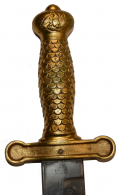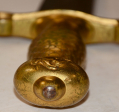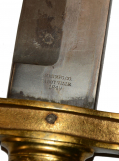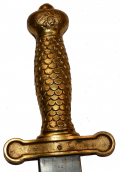site search
online catalog
MILITIA RIFLEMAN’S KNIFE WITH A M1849 AMES MOUNTED RIFLEMAN’S BLADE MOUNTED AS A SHORT SWORD

$3,850.00
Quantity Available: 1
Item Code: 1220-01
Shipping: Determined by Method & Location of buyer
To Order:
Call 717-334-0347,
Fax 717-334-5016, or E-mail
This knife uses a brass hilt in the form of the Model 1833 Short Sword and the blade of the Model 1849 Rifleman’s Knife. Just 1,000 of the latter weapons were supplied by Ames on contract with the U.S. government in 1849 to arm the regiment of mounted riflemen, whose M1841 rifles were not fitted with bayonets. These knives featured a straight, double-edge spearpoint blade with a 3-inch sharpened false edge, brass crossguard, and 2-piece maple grips fastened with 3 rivets and pierced in the bird’s-head pommel for lanyard ring, and were housed in a brass mounted leather scabbard with frog stud.
The Model 1833 short sword was larger and heavier, with double-edge, fluted blade mounted with a scaled or feathered grip, housed in a brass mounted, black leather scabbard. These are familiar from their later use by heavy artillery, but initially served other functions as well, such as NCO swords for infantry. They were impressive weapons, modeled on a French pattern, but evoked the Roman gladius and were fitting weapons for the Republic and gained even wider use in the militia. Privates of uniformed volunteer militia companies sometimes carried them even if equipped as standard, musket and bayonet bearing infantry. Some companies purchased their own custom etched versions, as did some fraternal organizations. They were best sellers in the early years for Ames, who waged an active marketing campaign encouraging states to request them from the central government as part of their allotment of arms under the militia act, which for some state officials likely seemed the next best thing to free.
In this case a hilt following the 1833 short sword pattern, complete with feathered grip and eagle impressed pommel, was mounted on a rifleman’s knife blade, even if a little awkwardly by having an exposed rivet run through the crossguard to use existing holes in the blade tang. We see no markings on the hilt. The ricasso is stamped, “AMES MFG CO. / CABOTVILLE / 1849” on the reverse and on the obverse “US,” but without the “WD” mark of inspector William Dickinson, a civilian employee at the Springfield Amory from about 1848 to 1850 and whose work seems to have been confined to inspecting Ames products. (Cole, US Mil. Knives, has this reversed in his text with his line drawings correct.) The omission of inspection mark indicates blade was either produced in excess of those needed to fulfil the contract or was rejected for some reason in doing so. We also note that it omits the sharpening of the false edge, something likely would have been done in the final, finishing phases.
The original purchaser of the knife is unknown, but it seems likely to have been a militia rifle company, mounted or not, who wanted a rifleman’s knife, but one with a more impressive hilt than the US issue version, perhaps like those carried in some rival companies of the “elegant elite.” In any case, this is a very rare knife and the condition is excellent. [sr] [ph:L]
~~~~~~~~~~~~~~~~~~~~~~~~~~~~~~~~~~~
THIS ITEM, AS WITH ALL OTHER ITEMS AVAILABLE ON OUR WEB SITE,
MAY BE PURCHASED THROUGH OUR LAYAWAY PROGRAM.
CLICK HERE FOR OUR POLICIES AND TERMS.
THANK YOU!
Inquire About MILITIA RIFLEMAN’S KNIFE WITH A M1849 AMES MOUNTED RIFLEMAN’S BLADE MOUNTED AS A SHORT SWORD
For inquiries, please email us at [email protected]
Most Popular
Historical Firearms Stolen From The National Civil War Museum In Harrisburg, Pa »
Theft From Gravesite Of Gen. John Reynolds »
Selection Of Unframed Prints By Don Troiani »
Fine Condition Brass Infantry Bugle Insignia »
British Imported, Confederate Used Bayonet »
Scarce New Model 1865 Sharps Still In Percussion Near Factory New »
featured item
ARMED CONFEDERATE LIEUTENANT COLONEL
This uncased eighth-plate tintype is a very clear studio view of a Confederate lieutenant colonel wear frock coat, narrow brim hat, gauntlets and tall boots. He has tilted his hat slightly to one side and wears a sort of tight-lipped smile. His… (1138-2029). Learn More »
site search
Upcoming Events
May 16 - 18: N-SSA Spring Nationals, Fort Shenandoah, Winchester, VA Learn More »













